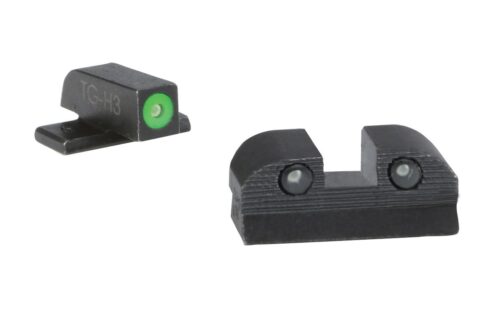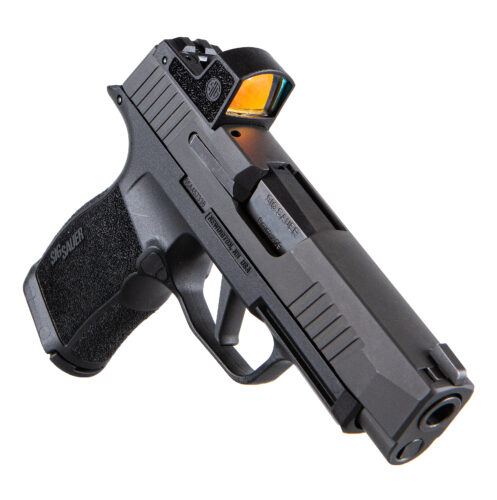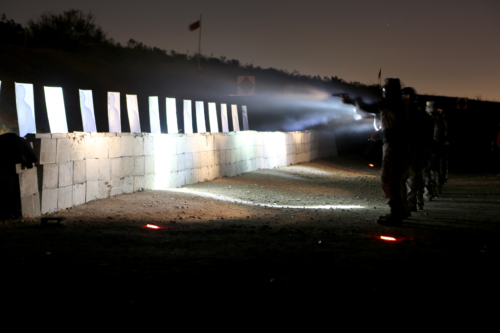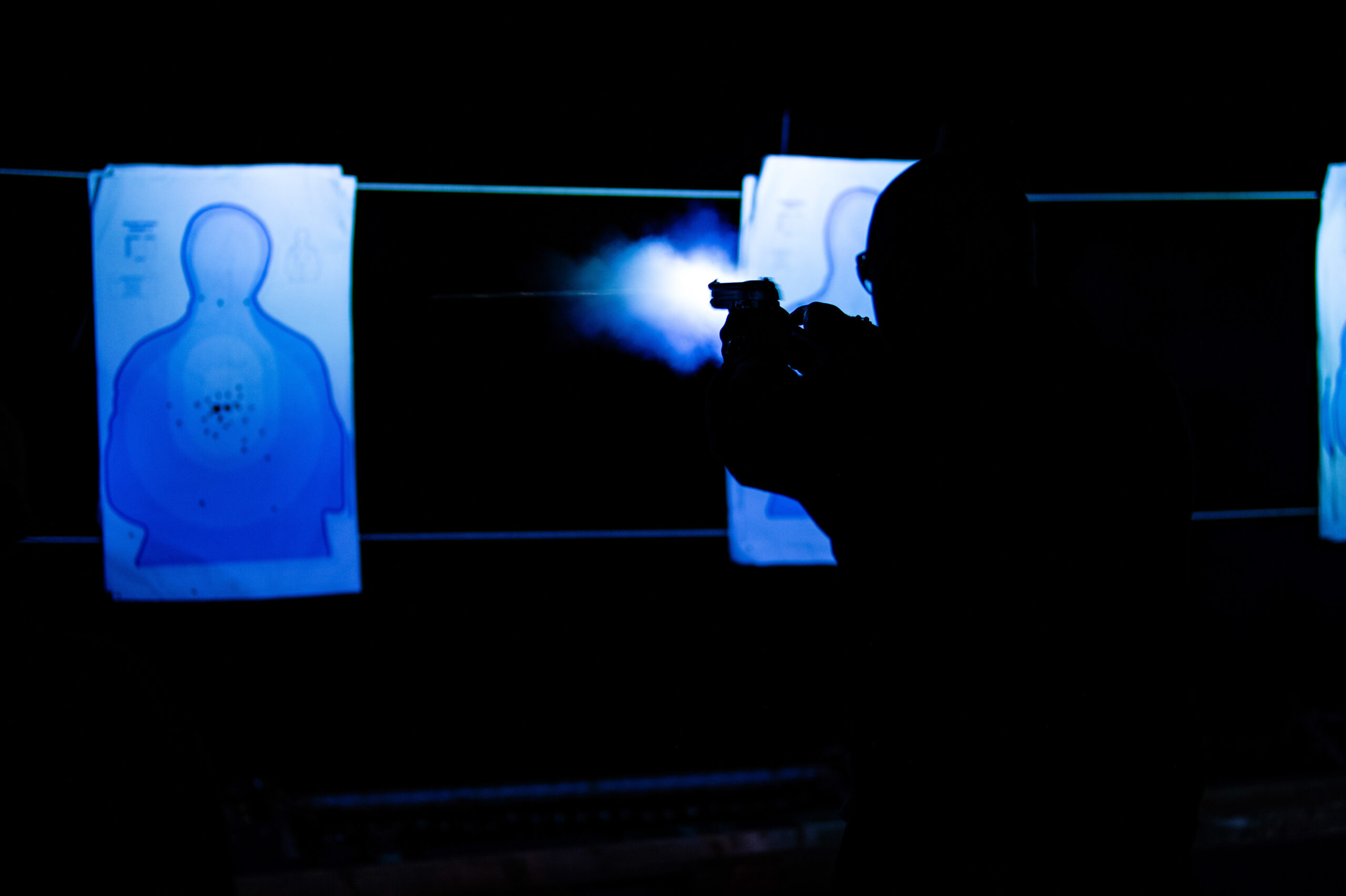We all know that most violent crimes take place at night or in diminished light. The ability to engage and hit targets in low-light scenarios Is a critical skill for everyone who carries a firearm. The importance of low-light shooting skills isn’t diminished during daylight hours. During the day, there are many situations in which you are faced with reduced or inconsistent light.
Ambient light isn’t the only factor that you will need to with. In a lethal force encounter, your visual acuity will be further reduced by the fact that you and your assailant will frequently be in motion prior to and during a shooting. And add to this the effects of stress and fear which also adversely affect your visual acuity. Hormones secreted during periods of high stress or acute fear dramatically decrease visual functioning.
Having the right sights is essential. Although they have only become common relatively recently, night sights have been available for over 60 years. Many handguns now come standard from the factory equipped with night sights or are available with them installed as a factory option.
Handgun night sights can be divided into two categories: illuminated iron sights and electro-optical sights. All of these sights are equally usable in dayight. Laser aimers also fall into the category of low-light sighting devices but they are active aiming devices / target designators and thus outside the scope of this article. Look for an article on laser aimers for handguns in the future.
Photoluminescent Sights
Photoluminescent night sights need to be charged by exposure to light. They utilize what’s sometimes referred to as “glow-in-the-dark paint.” The paint contains special pigments, usually strontium aluminate or copper-activated zinc sulfide, that it allows it to absorb photons from multiple light sources which causes excitation that’s observed as the release of light, i.e,, a glow in the dark effect.
The length of time that they glow and the brightness depends on pigments used and the previous light exposure type and duration. The latest generation strontium aluminate technology offers up to ten times higher brightness than previous zinc sulfide–based material, and may be seen for up to three to five hours after exposure to sunlight or artificial light (500 lux) for about 10 minutes.

Radioluminescent Sights
Radioluminecsent night sights require no charging. They’re self-powered and produce a consistent luminosity that does not fade during the night. Illumination is provided by special inserts consisting of small glass capsules filled with tritium, a radioactive isotope of hydrogen. The inner walls of the capsules are coated with a phosphor compound. As the tritium decays, beta rays are produced. The beta rays strike the phosphor particles on the inside of the glass, causing them to emit visible light.
The color of the light emitted is determined by the type of phosphor that is used. Green, yellow and orange light-emitting capsules are available. Green is the brightest color and the easiest for the human eye to see in low light, followed by yellow and then orange. Other colors could be provided but would be too dim to be practical.
Night sights are available in a variety of fixed-sight and adjustable-sight models in both three-dot systems and bar-dot systems. Although green three-dot systems are the most common, many shooters prefer two-color night sights with green front and yellow rear dots.
The use of two colors provides more distinction between the front and rear sights and helps avoid the possibility of momentary confusion as to which dot is which. Many shooters also find that two-color night sights make it easier for them to concentrate on front sight in low-light conditions, aiding accuracy.
Tritium has a half-life of 12.3 years. The brightness of the capsules will diminish as the tritium decays over time. The sights will have lost approximately 50% of their illumination at the half-life. From a practical standpoint, tritium night sights may remain serviceable for up to 15 years.
The tritium doesn’t pose any health hazards whatsoever. The amount of radiation emitted is minuscule and classified by the US Nuclear Regulatory Commission (NRC) as “below regulatory concern.” Even if the capsules were to rupture, there would not be any hazard.
Combo Sights & Fiber Optics
Combination tritium and photoluminescent night sights are designed so that the short-term glow of the paint would aid in transitional lighting situations, while the tritium inserts provide a long-term glow.
Tritium fiber-optic (TFO) night sights are also available. They’re true night sights, designed to give you the advantages of both tritium night sights and fiber optics. The fiber optic provides an easy-to-distinguish contrasting material. The tritium glow is not distinguishable in bright light which is where the fiber optics shine.
Fiber optics emit no light and require an external light source. Fiber optics are by themselves high visibility day sights, although they could function as a quasi-night sight that aids in sight acquisition, depending on the lighting and if used in conjunction with a flashlight.

Electro Optical (Reflex) Sights
Electro-optical reflex sights for handguns are a comparatively recent innovation. Miniature reflex sights, often referred to as mini red dot sights (MRDS), are considered by many to be the future of handgun sights. Reflex sights with green dots are also now hitting the market. For purposes of this article, we will use MRDS generically for both red and green dot optics/sights.
Miniature open reflex sights first became popular in competitive shooting due to their advantages and have become increasingly popular for both duty and personal/home defense. The biggest downside and a major factor in preventing more use has been their cost.
The cost of outfitting your pistol with a MRDS has come down substantially. Durability and battery life have also improved greatly, to the point that they are no longer a factor for duty use. Most major handgun manufacturers now offer pistols that come with the slide already milled to accept a MRDS, making it easier and less costly to mount optics.
A MRDS provides you with a combination of speed and precision under virtually any lighting condition. The human eye can only focus on one distance at a time. Shooters with aging eyes or less than perfect vision will find a MRDS much easier to to use than iron sights.
Murphy being what he is, most users back up their MRDS with tall iron night sights designed for use with suppressors. Suppressor sights provide an elevated sight picture that is able to co-witness with a slide-mounted MRDS. Some MRDS are designed with an integral rear sight built into the body. For duty or personal defense, backup sights are essential.
Getting On Target
In order to accurately aim your weapon, you need to be able to clearly see the sights. This is often difficult or impossible to do with standard sights in low-light situations. Tests that were conducted at the FBI Academy demonstrated an increase in night-firing accuracy by as much as 500% when tritium night sights were used.
Internal testing done by Trijicon® has shown that most users are 10 to 30% faster getting center-mass hits on a target with the company’s HD™ Night Sights than with standard pistol sights. Their data shows this to be true regardless of the user’s current proficiency level in pistol shooting, and is due to the ability to obtain a faster focus on the front sight of the HD Night Sights. These results would hold true for other high visibility night sights. It would also be fair to assume that MRDS would be as fast or faster.
Night sights are rapidly becoming considered to be essential equipment for law enforcement duty firearms. MRDS are also growing in popularity. Nevertheless the fact remains that most firearms today aren’t equipped with night sights due to the added cost.
Night Sights in Perspective
According to statistics, most shootings take place at distances of 20 feet or less. Many of the shootings may be classified as spontaneous shootings, where there was no warning and the weapon was in the holster at the outset. From a practical standpoint, there’s often little or no time to see the sights (even if the sights would be visible), nor any real opportunity to use them.
At these short ranges, a trained and practiced shooter shouldn’t have any trouble getting center-of-mass hits in low light, even with the ability to see or use the sights impaired. This is due to what’s commonly and erroneously referred to “muscle memory.”

Every time a shooter draws and aims a handgun, the action becomes imprinted in the shooters. Eventually, typically after several thousand repetitions, the conscious execution of skills becomes subconscious and automatic. The weapon’s sights are instinctively aligned and little or no sight correction is needed.
Do night sights improve hit ratios on the street? The answers aren’t clear cut. Most individuals involved in spontaneous shooting scenarios report either not using their sights or not remembering if they did.
When faced with a threat, the human mind instinctively focuses on the threat. Plus the physiological effects of extreme stress can make it difficult if not impossible for the eyes to get a clear sight picture. Training can help to overcome this to some extent. The issues of threat focus and clear sight picture are not an issue with a MRDS. You simply put the dot in the sight window on the target.
This isn’t to say that iron night sights aren’t advantageous to have in close-range, spontaneous shooting scenarios. Night sights allow you to use flash sight picture in situations where this would otherwise be impossible due to low ambient lighting. According to proponents, the flash sight technique, also known as the front sight method is easier to learn than point shooting and inherently more accurate. With practice there is very little loss of speed by using this technique.
At longer distances, or in situations where there is time to use the sights, night sights really come into their own. However, it needs to be recognized that in many situations where there isn’t enough ambient light to see standard sights, there also isn’t enough ambient light to clearly identify and evaluate threats.
As I discussed in a previous article, a research study conducted by the Los Angeles Police Department found that officers have difficulty in distinguishing between lethal and non-lethal objects in levels of light less than that produced by 0.5 foot candles — routine working conditions at night.
Under these circumstances, you’ll need the illumination of a white light, irrespective of whether your weapon has night sights, standard sights or a laser aimer. The application of a powerful white light can also blind the opponent and impair his ability to shoot us at critical moments. It can create what has been referred to as a photonic barrier providing concealment from the opponent.
A weapon light will enhance your low light fighting capabilities. Just keep in mind that having a weapon light doesn’t eliminate the need to for a hand held flashlight. A flashlight is still essential for general illumination tasks and as a backup.
A weapon light is part of the weapon system and needs to be treated as such. It’s an adjunct to a flashlight and not a replacement for it. If you’re not justified in drawing and pointing your gun, you’re not justified in pointing a weapon light. A flashlight allows you to safely assess the situation without pointing your gun at a non-threat.
Night sights excel in non-spontaneous shooting scenarios where the target is clearly identifiable and standard sights could not be seen or wouldn’t be silhouetted against the target. Night sights are invaluable in these situations. Although they certainly aren’t without their limitations, night sights are a valuable tactical aid.
Low-light training is essential. Despite the fact that most shootings take place in reduced light, most training takes place in daylight and little or no training is given in low-light tactics. Take a course, such as the excellent Low Light Pistol Operator course offered by the SIG SAUER® Academy.
Sources
SIG SAUER www.sigsauer.com
SIG SAUER Academy www.sigsaueracademy.com
Trijicon www.trijicon.com
*The views and opinions expressed on this website are solely those of the original authors and contributors. These views and opinions do not necessarily represent those of Spotter Up Magazine, the administrative staff, and/or any/all contributors to this site.


How about a Tritium front sight on a defensive shotgun?? what do you think? is it worth it, with barrel length and the shot guns application?
I consider it very worthwhile to have on a duty / defensive shotgun for use in low-light situations. I have one on mine.
I entered on duty with the U.S. Border Patrol in the 70s. We had adjustable sighted .357 Magnum revolvers with blued sights.
We were taught to pick up our sight picture in the flash of the first shot.
In the 90s when we adopted the Beretta Model 96 with night sights things changed.
Those sights were very visible.
Other than the sights I did not care for the Beretta.